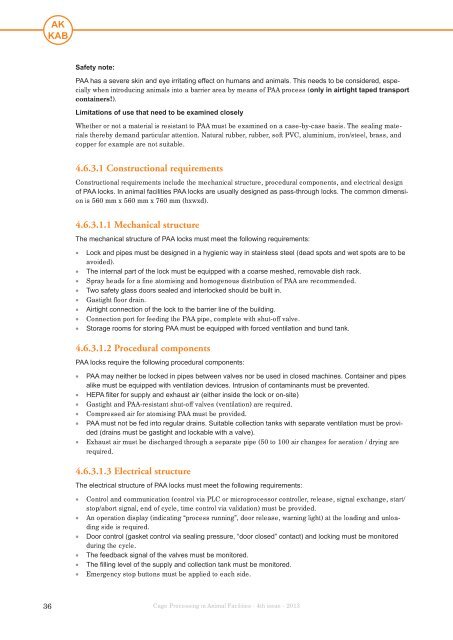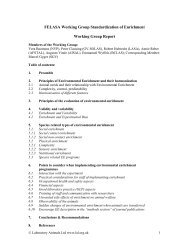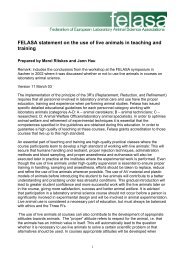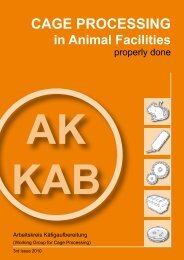CAGE PROCESSING in Animal Facilities - Felasa
CAGE PROCESSING in Animal Facilities - Felasa
CAGE PROCESSING in Animal Facilities - Felasa
- No tags were found...
You also want an ePaper? Increase the reach of your titles
YUMPU automatically turns print PDFs into web optimized ePapers that Google loves.
Safety note:PAA has a severe sk<strong>in</strong> and eye irritat<strong>in</strong>g effect on humans and animals. This needs to be considered, especiallywhen <strong>in</strong>troduc<strong>in</strong>g animals <strong>in</strong>to a barrier area by means of PAA process (only <strong>in</strong> airtight taped transportconta<strong>in</strong>ers!).Limitations of use that need to be exam<strong>in</strong>ed closelyWhether or not a material is resistant to PAA must be exam<strong>in</strong>ed on a case-by-case basis. The seal<strong>in</strong>g materialsthereby demand particular attention. Natural rubber, rubber, soft PVC, alum<strong>in</strong>ium, iron/steel, brass, andcopper for example are not suitable.4.6.3.1 Constructional requirementsConstructional requirements <strong>in</strong>clude the mechanical structure, procedural components, and electrical designof PAA locks. In animal facilities PAA locks are usually designed as pass-through locks. The common dimensionis 560 mm x 560 mm x 760 mm (hxwxd).4.6.3.1.1 Mechanical structureThe mechanical structure of PAA locks must meet the follow<strong>in</strong>g requirements:• Lock and pipes must be designed <strong>in</strong> a hygienic way <strong>in</strong> sta<strong>in</strong>less steel (dead spots and wet spots are to beavoided).• The <strong>in</strong>ternal part of the lock must be equipped with a coarse meshed, removable dish rack.• Spray heads for a f<strong>in</strong>e atomis<strong>in</strong>g and homogenous distribution of PAA are recommended.• Two safety glass doors sealed and <strong>in</strong>terlocked should be built <strong>in</strong>.• Gastight floor dra<strong>in</strong>.• Airtight connection of the lock to the barrier l<strong>in</strong>e of the build<strong>in</strong>g.• Connection port for feed<strong>in</strong>g the PAA pipe, complete with shut-off valve.• Storage rooms for stor<strong>in</strong>g PAA must be equipped with forced ventilation and bund tank.4.6.3.1.2 Procedural componentsPAA locks require the follow<strong>in</strong>g procedural components:• PAA may neither be locked <strong>in</strong> pipes between valves nor be used <strong>in</strong> closed mach<strong>in</strong>es. Conta<strong>in</strong>er and pipesalike must be equipped with ventilation devices. Intrusion of contam<strong>in</strong>ants must be prevented.• HEPA filter for supply and exhaust air (either <strong>in</strong>side the lock or on-site)• Gastight and PAA-resistant shut-off valves (ventilation) are required.• Compressed air for atomis<strong>in</strong>g PAA must be provided.• PAA must not be fed <strong>in</strong>to regular dra<strong>in</strong>s. Suitable collection tanks with separate ventilation must be provided(dra<strong>in</strong>s must be gastight and lockable with a valve).• Exhaust air must be discharged through a separate pipe (50 to 100 air changes for aeration / dry<strong>in</strong>g arerequired.4.6.3.1.3 Electrical structureThe electrical structure of PAA locks must meet the follow<strong>in</strong>g requirements:• Control and communication (control via PLC or microprocessor controller, release, signal exchange, start/stop/abort signal, end of cycle, time control via validation) must be provided.• An operation display (<strong>in</strong>dicat<strong>in</strong>g “process runn<strong>in</strong>g”, door release, warn<strong>in</strong>g light) at the load<strong>in</strong>g and unload<strong>in</strong>gside is required.• Door control (gasket control via seal<strong>in</strong>g pressure, “door closed” contact) and lock<strong>in</strong>g must be monitoreddur<strong>in</strong>g the cycle.• The feedback signal of the valves must be monitored.• The fill<strong>in</strong>g level of the supply and collection tank must be monitored.• Emergency stop buttons must be applied to each side.36Cage Process<strong>in</strong>g <strong>in</strong> <strong>Animal</strong> <strong>Facilities</strong> · 4th issue · 2013






